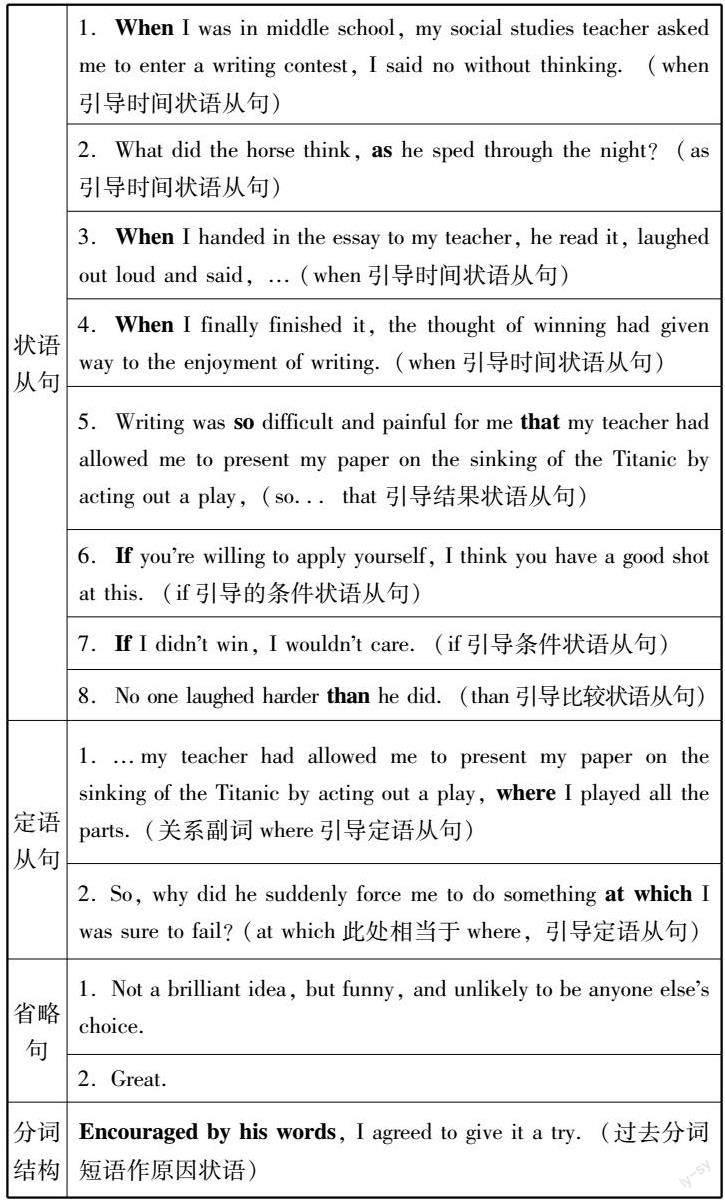基于“语言协同”研析2023年新高考全国I卷读后续写
2023-08-26余爱香
余爱香

在读后续写过程中,学生要揣摩原文语言风格,续写语言应延续原文的语言风格。笔者基于语言协同的角度,对2023年新高考I卷读后续写进行探讨。
一、真题再现
When I was in middle school, my social studies teacher asked me to enter a writing contest, I said no without thinking. I did not love writing. My family came from Brazil, so English was only my second language. Writing was so difficult and painful for me that my teacher had allowed me to present my paper on the sinking of the Titanic by acting out a play, where I played all the parts. No one laughed harder than he did.
So, why did he suddenly force me to do something at which I was sure to fail? His reply: “Because I love your stories. If youre willing to apply yourself, I think you have a good shot at this.” Encouraged by his words, I agreed to give it a try.
I chose Paul Reveres horse as my subject. Paul Revere was a silversmith (银匠) in Boston who rode a horse at night on April 18, 1775 to Lexington to warn people that British soldiers were coming. My story would come straight from the horses mouth. Not a brilliant idea, but funny, and unlikely to be anyone elses choice.
What did the horse think, as he sped through the night? Did he get tired? Have doubts? Did he want to quit? I sympathized immediately. I got tired. I had doubts. I wanted to quit. But, like Reveres horse, I kept going. I worked hard. I checked my spelling. I asked my older sister to correct my grammar. I checked out a halfdozen books on Paul Revere from the library. I even read a few of them.
When I handed in the essay to my teacher, he read it, laughed out loud and said, “Great. Now, write it again.” I wrote it again, and again and again. When I finally finished it, the thought of winning had given way to the enjoyment of writing. If I didnt win, I wouldnt care.
注意:1. 续写词数应为150个左右;2. 请按如下格式在答题卡的相应位置作答。
A few weeks later, when I almost forgot the contest, there came the news.
I went to my teachers office after the award presentation.
二、语言特征
1.语言形式
(1)原文语言形式相对较简单,共5段话,323个词,复合句9句,简单句17句。其中状语从句8句,定语从句2句,省略句2句。笔者对原文的语言形式进行了分类,如下表所示。
2.语言风格
(1)细节描写使用了大量的内心独白
内心獨白是人物心理的直接而真实的坦露,能够有力地表现人物性格。独白部分有:第二段“So, why did he suddenly force me to do something at which I was sure to fail?”, 第四段“I sympathized immediately. I got tired. I had doubts. I wanted to quit. ”,最后一段“...the thought of winning had given way to the enjoyment of writing. If I didnt win, I wouldnt care.”。这些内心独白,反映了作者从“自我怀疑、自我否定”到 “自我成长、自我突破、享受写作、不在乎结果”的心理变化过程,有力反映了作者坚韧不拔的性格特点。
(2)使用了“排比”修辞手法
排比即一个句子中把结构相同或相似、意思密切相关、语气一致的词语或句子成串地排列的一种修辞方法,以增强语言的气势和表达效果。例如第四段“Did he get tired? Have doubts? Did he want to quit? ”这三个短小精悍的排比句把马同时也是作者“我”内心的惶恐、犹豫、怀疑等体现得惟妙惟肖。
(3)使用了“反复”修辞手法
反复是英语中一种重要的修辞方法。它主要指作者或根据表达的需要或为强调某个意思、突出某种感情,有意识地重复运用某些词语或句子,使之收到修辞上的效果。例如:第四段句子“I kept going. I worked hard. I checked my spelling. I asked my older sister to correct my grammar. I checked out a half-dozen books on Paul Revere from the library. I even read a few of them.”作者采用了“首语反复”的修辞手法,句首连续用了六个I,恰好表现了作者面对困难时的果断、坚韧与坚持的性格特征。句子“I wrote it again, and again and again.”,again进行了三次反复,生动描述了作者为此次比赛所作的努力,展现了他坚持不懈的一面。
(4)对马的描写使用了“拟人”修辞手法
作者对马进行了心理描写,进行了人格化处理。“What did the horse think, as he sped through the night? Did he get tired? Have doubts? Did he want to quit? But, like Reveres horse, I kept going.” 这些句子对马进行了人格化描写,使语言表达生动、有生命力。
三、续文赏析
基于以上分析,可知原文使用的语言并不复杂,长难句较少,理解难度较低。在所使用的句型结构里,简单句和状语从句出现较多。另外,描写心理活动时,作者着重用简短、朴实的内心独白进行描写,而人物间的对话则着墨较少。
从语言协同的角度来讲,续文应沿用原文简洁朴实、生动的语言风格,不必过于追求生僻词和复杂句式。在续写时,句式方面可简单句与复合句并用,交替使用长短句,并适当加入非谓语动词和和其它句式结构;此外,可沿用原文内心独白方式描写心理活动;最后,可恰当应用反复、排比、拟人等修辞手法进行描写。值得一提的是,原文中多次提及老师的笑laugh,第一次“No one laughed harder than he did.”,第二次“When I handed in the essay to my teacher, he read it, laughed out loud, and said...”,在續写的时候也可以再次沿用“笑”描写老师,刻画人物形象。
续写下水文如下:
A few weeks later, when I almost forgot the contest, there came the news. ①The news that I won the first prize just felt like a dream. ②I rubbed my eyes again and again.③ My mind raced. ④What if my teacher had not encouraged me? What if I had quit half way? What if my sister had not helped correct my writing? In spite of the pain and doubt on the the road, I eventually made it. ⑤Immersed in excitement and joy, I knew it was my social studies teacher that I should be most grateful to. Holding the golden medal on the stage, I couldnt wait to share the good news with him.
I went to my teachers office after the award presentation. ⑥When I told him the news, he laughed out loud just like before, pride releasing from his eyes.⑦Tears misting my vision, I hugged him tightly, expressing my heart-felt gratitude to him. He patted my back gently and said firmly,⑧“Distance tests a horses strength and time tests a persons perseverance.” From then on, despite the challenges and obstacles that I faced ahead,⑨I never stopped writing, as Reveres horse never stopped speeding that night.
①运用了明喻的修辞手法,获得一等奖的消息就像是一个梦felt like a dream,描写出了作者的“难以置信”。②运用了反复修辞手法again and again,同样刻画出作者难以置信的心理活动。③my mind raced运用了拟人的修辞方式,race形象生动地描写出了作者此时往事涌上心头的复杂的内心活动。④运用了排比修辞手法,连续三个What if排比设问,既呼应了原文,又表达了所取得的成绩与“老师的鼓励、自己的坚持、姐姐的帮忙纠正”息息相关。⑤Immersed in excitement and joy, Holding the golden medal 均用分词短语作状语。⑥是when引导的时间状语从句,laugh呼应原文的laugh,生动形象地刻画出一位阳光开朗、幽默风趣、善于激励学生、充满正能量的老师形象。⑦Tears misting my vision,充分发挥了喻体mist的作用,表达生动鲜活。⑧反复运用了“test”,同时运用了对偶的修辞手法,凸显了“路遥知马力,时间久了才能检测一个人的坚韧”,升华了文章主题意义。⑨在续写结尾处呼应原文,再次将马人格化,描写未来将继续像马一样不知疲惫地坚持写作之路。
总而言之,读后续写过程中,首先在阅读环节,学生应能够对原文语言形式和语言风格进行判断和分析,尤其是对原文所使用的修辞手法做出判断,对修辞手法的表达效果做出分析、理解和赏析;其次在续写环节,学生应沿用原文语言风格,恰当地借助多元修辞方法来强化语言效果,增强语言感染力,使得表达主题更为突出,内容更加生动有趣。
责任编辑 吴昊雷
